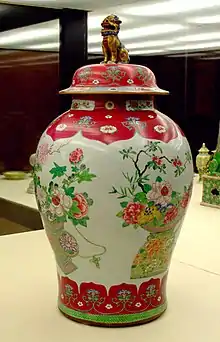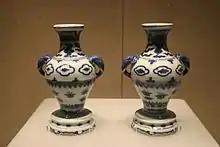Porcelain trade in Qing China
Porcelain trade in Qing China was an important trade during the late Ming dynasty and throughout the Qing dynasty.[2] The porcelain that was traded reflected a transition of creative influences that altered the way porcelain looked but its high demand in Europe.[3]


Economy Trade
In the late of Ming dynasty there were many kilns created that led the Ming dynasty to be economically well off.[3] The late emperors of the Ming dynasty like Jiajing and Wanli made sure there were more kilns created in Jingdezhen.[4] There was also a further research and study on the type of materials and techniques in the creation for porcelain during Qing china.[4] Since there was a high demand the Ming realized that there needed a proper allocation of funds and management to create a steady porcelain supply.[4] Thus, these additional kilns and management would help the production of porcelain as well as the economical growth of the early Qing dynasty period.[4] However, once the Ming Dynasty came to an end there was a suffering that occurred during the Qing dynasty when Jingdezhen became a prime location for political turmoil and military campaigns during the Taiping Rebellion.[4] These invasions caused a temporary stalling in the creation for porcelain.[4]
Once the Qing dynasty sought to bring back porcelain in the trade they developed a more efficient way to transport the Porcelain goods.[4] The Qing emperors like Kangxi helped to initiate a furthering of maritime trade which would help the growth of porcelain trade.[5] By using the Yangtze River not only was porcelain materials cheaper to send but the final good could be transported to other regions that were not accessible.[4] Kangxi furthered the trade for porcelain by allowing an organization of private maritime trade that allowed families who own private kilns.[5] Once again the porcelain trade was thriving, and helped to boost the economy of the early Qing empire.[4]
Qing Culture of Porcelain
There is a difference in the way the Qing porcelain was created and why it was thriving in the trading atmosphere.[1] The Ming, prior to the overthrowing by the Qing, were using two color glazes for their porcelain. The two color porcelain was something that many connoisseurs from Europe sought after, but at one point were done buying.[1] Once the Qing came into power and began to change the artistic aspect of the porcelain there were experiments and techniques to use five colors.[2] Furthermore, the Qing focused on different artistic elements when producing their porcelain, like the use of color and putting porcelain at a higher temperature to get a glossier coat.[2][3] Also, many of the private kilns were trusting their own potters to create freely, a creative freedom that would help to further the creative porcelain pieces.[6] A more creative porcelain piece would bring more profit and boost to the Qing economy.[6]
There was a researching of what techniques were better in the production of these porcelain goods, and this would help to further the marketing aspect of business in Jingdezhen (the porcelain capital of China).[4] The various use of kilns and the changes of temperature helped to produce a brilliance and assortment of porcelain that helped to thrive a part of the Qing economy.[2][7] Emperor Kangxi's decisive decision to rebuild the kilns after the rebellion would help to provide an economic benefit to the Qing economy.[7] The furthering of the color techniques would go long into the Kangxi emperor's time and would further showcase the Qing culture through the artistic prints and designs on the porcelain. This same coloring and technique process is still used in today's porcelain from the Qing time period because there has been no substitute to create the same color and appearance on porcelain.[7]
Comparing Ming and Qing Porcelain


See also
References
- "Qing Dynasty Ceramics".
- Wen-Chin, Hsu (1988). "Social and Economic Factors in the Chinese Porcelain Industry in Jingdezhen during the Late Ming and Early Qing Period, ca. 1620-1683". The Journal of the Royal Asiatic Society of Great Britain and Ireland. No. 1 (1): 135–159. doi:10.1017/S0035869X00164196. JSTOR 25212250.
- Medley, Margaret (1987). "The Ming - Qing Transition in chinese Porcelain". Arts Asiatiques. 42: 65–76. doi:10.3406/arasi.1987.1217. JSTOR 43486524.
- Dillon, Michael (1992). "Transport and Marketing in the Development of the Jingdezhen Porcelain Industry during the Ming and Qing Dynasties". Journal of the Economic and Social History of the Orient. 35 (3): 278–290. doi:10.1163/156852092x00156. JSTOR 3632734.
- Zhao, Gang (2013). The Qing Opening to the Ocean: Chinese Maritime Policies, 1684-1757. University of Hawai'i Press. pp. 116–136.
- 1940-, Finlay, Robert (2010). The pilgrim art : cultures of porcelain in world history. Berkeley: University of California Press. ISBN 978-0520244689. OCLC 613205918.CS1 maint: numeric names: authors list (link)
- "Qing Dynasty Porcelain".